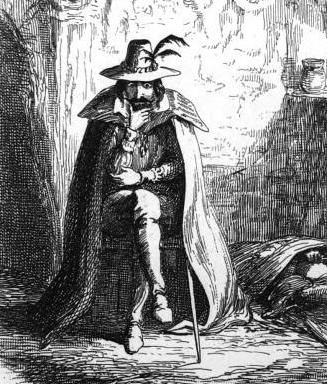Involving thirteen participants, Gunpowder Plot of 1605 was an attempt to assassinate the English King James I and other important targets by blowing the Parliament of England. Led by Robert Catesby and involving Guy Fawkes, the plot was a formed due to the persecution of Catholics in Protestant England. Know more about it through these 10 facts.
#1 ENGLAND BECAME INCREASINGLY PROTESTANT DURING THE REIGN OF ELIZABETH I
Henry VIII, who became king of England in 1509, is credited with transforming England from a Catholic country to a Protestant one. When Henry’s daughter Elizabeth I took over the reins of the country, she furthered the Protestant cause and Catholicism was marginalised. By the time of her death in 1603, Catholic priests were forced to say Mass in secret in private houses and Catholics were required to attend Protestant services.

#2 DISAPPOINTMENT OVER RELIGIOUS POLICIES WAS ITS MAJOR CAUSE
When James I, who had a Catholic wife, succeeded the throne after Elizabeth’s death, the Catholics hoped that he would end the persecution of Catholics. However after showing positive signs in that direction early on, James succumbed to pressure from extreme Protestants and once again increased penalties on those who practised the Catholic religion. Discontent grew among Catholics and some were willing to take extreme measures.

#3 It WAS THE BRAINCHILD OF ROBERT CATESBY
Gunpowder Plot was organized by Robert Catesby, an English Catholic whose father had been persecuted by Queen Elizabeth I. The initial plan was formed on 20 May 1604 in a London inn. Apart from Catesby, four other people were involved namely Thomas Wintour, John Wright, Thomas Percy and Guy Fawkes. Later eight more were recruited for carrying out the Gunpowder Plot taking the total number of conspirators to thirteen.
#4 ITS PRINCIPAL AIM WAS TO INSTALL A CATHOLIC MONARCH ON THE ENGLISH THRONE
The aim of the Gunpowder Plot was to blow up the House of Lords at the opening of English Parliament on 5 November 1605. This would lead to the death of England’s King James I along with other important targets attending the opening. Once the king and his parliament were dead, they planned to put James’ daughter Elizabeth on the throne thus replacing the country’s Protestant government with Catholic leadership.

#5 AN ANONYMOUS LETTER WAS INSTRUMENTAL IN REVEALING THE PLOT
On October 26, Lord Monteagle, a member of the House of Lords received an anonymous letter warning him not to attend the opening of the Parliament on November 5. Monteagle was the brother-in-law of one of the conspirators named Francis Tresham but the identity of the author of the letter has never been reliably established. The letter made its way to James I by November 1 and the king inferred that it was a plan for an explosion.

#6 THE MOST FAMOUS NAME ASSOCIATED WITH IT IS GUY FAWKES
The most famous participant of the Gunpowder Plot was Guy Fawkes. The conspirators had secured lease of a cellar beneath the House of Lords with Fawkes in charge of the gunpowder they stockpiled there. Hours before the attack was supposed to have taken place the authorities while conducting a search found Fawkes guarding 36 barrels of gunpowder – enough to reduce the House of Lords to rubble.

#7 ALL THE PARTICIPANTS IN THE GUNPOWDER PLOT WERE KILLED
After the plot’s discovery, most of the conspirators fled from London. Guy Fawkes initially maintained that he acted alone but after two days of torture he gave the identities of his co-conspirators. The plotters made their final stand at Holbeche House in Staffordshire, where several, including Catesby, died in a shoot-out with the king’s men. The eight that survived, including Fawkes, were executed by being hanged, drawn and quartered in January 1606.

#8 THERE IS A CONSPIRACY THEORY BY WHICH ROBERT CECIL WAS ITS MASTERMIND
After the discovery and failure of the Gunpowder Plot, new laws were instituted in England that eliminated the right of Catholics to vote, among other repressive restrictions. It would be another 200 years before these restrictions were fully lifted. There is a conspiracy theory which says that English Secretary of State, Robert Cecil, who wanted to end Catholicism in England planned the plot and its discovery to get James I to persecute the Catholics.

#9 5TH OF NOVEMBER IS STILL CELEBRATED IN BRITAIN AS GUY FAWKES NIGHT
Months after the failure of the Gunpowder Plot, Parliament of England passed the Observance of 5th November Act which called for a public, annual thanksgiving for the failure of the Plot. Since then the 5th of November is celebrated in Britain and is variously known as Bonfire Night, Fireworks Night, or Guy Fawkes Night. Effigies of Fawkes are burnt and firework displays and bonfire parties are common throughout Britain.

#10 THE WORD ‘GUY’ COMES FROM GUY FAWKES
A lot of literature has been written on Gunpowder Plot and its events have inspired many books, most famously William Shakespeare’s Macbeth. For Guy Fawkes Night children used to make effigies of Fawkes usually using old clothes and newspapers. These “guys” were exhibited in the street to collect money for fireworks. Due to this the word ‘guy’ was used to refer to an oddly dressed person in the in the 19th century and by the 20th and 21st centuries it came to mean ‘any male person’.

THE GUY FAWKES MASK

In 20th century Britain many masks depicting Guy Fawkes were sold to children before the Guy Fawkes Night. The Guy Fawkes mask grew in popularity after it was worn by the protagonist of the famous graphic novel of 1980s V for Vendetta which was adapted into a film with the same title in 2006. Since then the mask, which was designed by illustrator David Lloyd, has become a symbol of anti-government and anti-establishment protests around the world.

